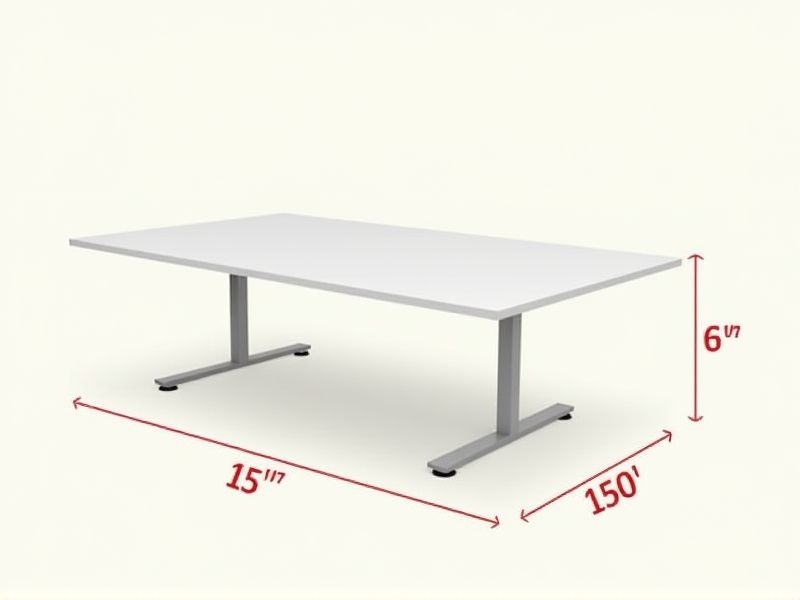
When selecting office furniture, knowing the standard dimensions can help you create an ergonomic and efficient workspace. For example, a typical office desk is about 29-30 inches (74-76 cm) high, with a width of 47-60 inches (120-152 cm), and a depth of 24-30 inches (61-76 cm). Standard office chairs usually have a seat height ranging from 16 to 21 inches (41-53 cm), ensuring most users can sit comfortably with their feet flat on the floor. Keeping these standard sizes in mind will help you maximize comfort and productivity while ensuring your office is well-organized and functional.
Desk Height
The standard desk height for office furniture typically ranges between 28 to 30 inches (71 to 76 centimeters) from the floor, catering to the average adult's ergonomic needs. This height enables comfortable typing and reduces strain on the wrists and back, which is essential for productivity during long working hours. Adjustable desk options are available, allowing individuals to customize their workspace to heights between 24 to 50 inches (61 to 127 centimeters), supporting both sitting and standing positions. Investing in a desk that meets these standards can significantly enhance your comfort and efficiency at work.
Chair Seat Depth
Chair seat depth, typically ranging from 15 to 20 inches, plays a crucial role in promoting ergonomic comfort and support in office furniture. An optimal seat depth allows for proper thigh support and encourages a healthy posture, reducing the risk of back pain during extended work hours. When selecting office chairs, ensure that the seat depth complements your body's dimensions to enhance productivity and comfort. Investing in adjustable seating options can provide the flexibility needed to accommodate various user preferences and body types.
Chair Seat Height
The standard chair seat height for office furniture typically ranges from 16 to 21 inches, accommodating the average desk height of 28 to 30 inches. Choosing a chair with adjustable seat height can significantly enhance ergonomic comfort, allowing you to align your feet flat on the floor for optimal posture. Proper seat height contributes to reducing strain on the lower back, promoting more productive work hours. When selecting your office chair, consider the seat height to ensure it meets both your personal comfort and the functional demands of your workspace.
Desk Width
Office desks typically have a standard width ranging from 48 to 72 inches, catering to various workspace configurations and user needs. A width of 60 inches is common, providing ample space for a computer, paperwork, and other essential items. Consider ergonomic factors; a desk that is too narrow can lead to discomfort during prolonged use. You should also account for additional decor or equipment when choosing the right desk width for your office environment.
Desk Depth
The standard desk depth for office furniture typically ranges from 24 to 30 inches, providing adequate space for monitors, documents, and office supplies. A desk depth of 30 inches is often favored for those using multiple monitors or extensive paperwork, ensuring comfort and efficiency in your workspace. Height-adjustable desks, which are increasingly popular, may also feature depth variations while maintaining ergonomic principles. Choosing the right desk depth can significantly enhance your productivity and overall workspace functionality.
Shelf Height
The standard shelf height for office furniture typically ranges from 48 to 72 inches, allowing for optimal storage and accessibility. A shelf height of 60 inches is commonly considered ideal for accommodating a variety of items, including books, binders, and office supplies. To enhance ergonomics, many designers recommend placing frequently used items within 30 to 48 inches from the floor, minimizing strain during access. When selecting office furniture, ensure your shelves align with these standards to promote an efficient and organized workspace.
File Cabinet Dimensions
Standard file cabinets typically measure 15 to 20 inches in depth, 30 to 42 inches in height, and 24 to 36 inches in width, accommodating various storage needs. Most file cabinets are designed to hold standard letter (8.5 x 11 inches) or legal-sized (8.5 x 14 inches) documents, with drawers that usually extend fully for easy access. It's essential for your office space to consider the weight capacity, often ranging from 50 to 100 pounds per drawer, ensuring durability and safety. Additionally, a well-organized file cabinet can enhance efficiency, as professionals often spend up to 30% of their work time searching for documents.
Conference Table Size
The standard size for a conference table typically ranges from 8 to 12 feet in length, accommodating up to 10 to 20 people comfortably. For smaller meetings, a 6-foot table may suffice, providing space for 4 to 6 individuals. When selecting the right conference table, consider the room dimensions; a table should allow at least 36 inches of clearance on all sides for easy movement. In addition, ergonomic designs and materials contribute to a professional atmosphere, enhancing productivity during discussions.
Cubicle Panel Height
The standard height for cubicle panel systems typically ranges from 48 inches to 66 inches, allowing for varying levels of privacy and collaboration. A 54-inch height is often preferred in open office layouts, as it balances visual separation with an open atmosphere. Many organizations opt for customizable panel systems, enabling adjustments in height up to 72 inches for enhanced privacy in managerial offices. Your choice in cubicle panel height can significantly impact employee productivity, communication, and overall workplace satisfaction.
Workstation Area
The optimal standard for office furniture in workstation areas emphasizes ergonomics and functionality, which can enhance employee productivity. Desks should range from 24 to 30 inches in height, accommodating various tasks, while chairs must provide lumbar support and adjustable features, ensuring comfort during prolonged use. Studies indicate that ergonomic office setups can reduce workplace injuries by up to 30%, highlighting the importance of investing in quality furnishings. Your selection of materials, such as durable fiberboard or solid wood, can also contribute to a sustainable office environment, with an expected lifespan of over ten years for well-maintained pieces.
